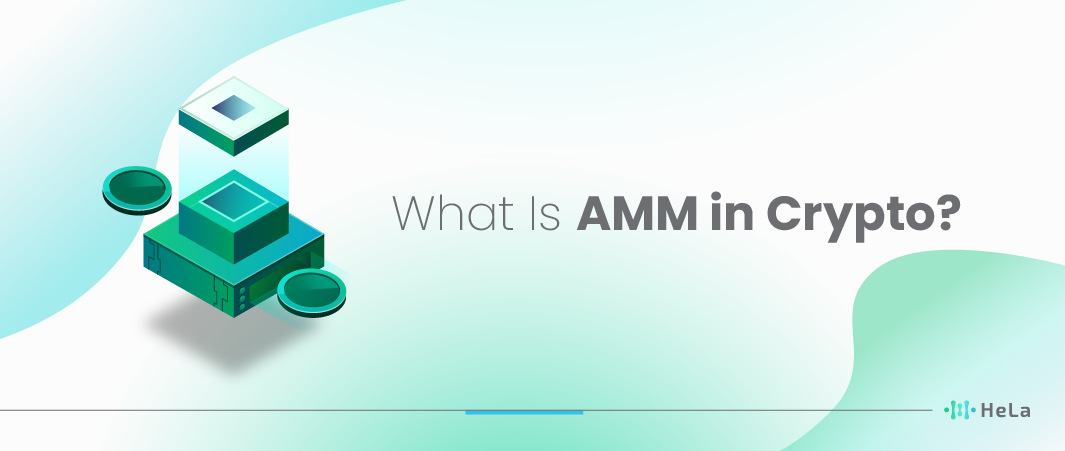Cryptocurrencies have truly revolutionized the financial world, bringing along a wave of innovations that are reshaping the way we handle digital assets. One of these groundbreaking innovations is known as Automated Market Makers (AMM) in crypto. So, you might be wondering, “What is AMM in crypto?” Well, you’ve come to the right place! In this article, we’ll simplify the concept of AMM, break down its key ideas, explore its advantages, and discuss the challenges it faces.
AMM in crypto refers to Automated Market Makers, which are a pivotal part of decentralized finance (DeFi). These smart contracts enable users to trade digital assets on blockchain platforms without relying on traditional intermediaries like brokers or banks. Instead, they rely on algorithms and liquidity pools to facilitate peer-to-peer transactions. One of the fundamental features of AMMs is their ability to automatically adjust prices based on supply and demand, which ensures liquidity and makes trading more efficient. This innovation has unlocked countless possibilities for crypto enthusiasts and investors worldwide.
Despite its many benefits, AMM in crypto also faces its fair share of challenges. One of the main concerns is impermanent loss, which occurs when the value of assets in a liquidity pool fluctuates. Additionally, regulatory scrutiny and security risks are important factors that the crypto community must address to ensure the continued growth and adoption of AMMs. Understanding these aspects of AMM in crypto is crucial for anyone looking to navigate the ever-evolving landscape of digital assets and decentralized finance.
What Is AMM in Crypto?
Automated Market Makers (AMMs) play a crucial role in decentralized finance (DeFi) ecosystems, and they are a fundamental building block for decentralized exchanges (DEXs). These systems utilize liquidity pools, which are pools of tokens locked in smart contracts that facilitate trading. Users can contribute their assets to these pools, earning fees in return, and these pools are used to provide liquidity for trading pairs.
The core principle behind AMMs is the constant product formula, which was popularized by the first and most famous AMM called Uniswap. This formula, often expressed as x * y = k, ensures that the product of the quantities of two assets in a liquidity pool remains constant. In simple terms, as users trade one asset for another, the price adjusts automatically based on supply and demand.
Traders can execute swaps on AMMs without needing a centralized order book or matching engine. Instead, they interact directly with the smart contract, which calculates the exchange rate based on the current pool balance. This decentralized nature of AMMs eliminates the need for traditional intermediaries and allows for 24/7 trading and greater accessibility.
One of the key benefits of AMMs is their permissionless nature. Anyone can create a liquidity pool for any trading pair by depositing an equal value of both assets, which fosters innovation and the listing of a wide range of tokens. This contrasts with centralized exchanges, which typically require a vetting process for listing new assets.
However, AMMs are not without their challenges. Impermanent loss is a concept that can impact liquidity providers when the prices of the assets in the pool change significantly. Additionally, AMMs are known for having higher slippage for larger trades compared to centralized exchanges with deep order books.
Despite these challenges, AMMs have become a cornerstone of the DeFi ecosystem, providing decentralized and permissionless access to a wide array of digital assets and trading opportunities. They continue to evolve and innovate, with various iterations and improvements being developed to address their limitations and enhance their functionality within the crypto space.
Also Read: What is CLI in Blockchain? Ultimate Beginners Guide
Key Concepts of AMM

To comprehend AMMs fully, it’s essential to grasp the following key concepts:
Liquidity Pools
AMMs rely on liquidity pools, which are pools of tokens locked in smart contracts. Users can contribute to these pools by depositing their assets, providing liquidity for trading pairs.
Constant Product Formula
Most AMMs, like Uniswap, employ a constant product formula to determine token prices. This formula ensures that the product of the quantity of two tokens remains constant, providing a mechanism for automated price adjustments.
Impermanent Loss
Liquidity providers in AMMs face a concept known as impermanent loss, where their funds may be temporarily worth less compared to simply holding the tokens. This is due to price fluctuations within the pool.
Decentralized Exchanges (DEXs)
AMMs are a fundamental component of decentralized exchanges. Unlike traditional centralized exchanges, DEXs operate on blockchain networks and do not rely on intermediaries to match orders. Instead, they utilize AMMs to facilitate the swapping of assets directly between users.
Token Swapping
One of the primary use cases of AMMs is token swapping. Users can exchange one cryptocurrency for another by providing liquidity to the relevant liquidity pool. The AMM algorithm calculates the exchange rate based on the constant product formula, ensuring that the liquidity pool remains balanced.
Arbitrage Opportunities
Due to the automated pricing mechanism of AMMs, arbitrage opportunities can arise. Arbitrageurs exploit price differences between different exchanges or liquidity pools to make profits. They buy tokens on one exchange where they are cheaper and sell them on another exchange where they are more expensive, effectively equalizing prices.
Volatility and Impermanent Loss
Impermanent loss occurs when the value of the tokens in a liquidity pool changes compared to holding them in a wallet. It is termed “impermanent” because the loss can be temporary and is often mitigated by fees earned from providing liquidity. Impermanent loss is more pronounced in highly volatile markets, where price fluctuations are frequent and significant.
Liquidity Provider Fees
Liquidity providers are incentivized to contribute assets to AMM pools by earning fees from trades that occur in those pools. A portion of the trading fees paid by users is distributed to liquidity providers in proportion to their contribution to the pool. This provides an opportunity for users to earn passive income in the form of fees.
Liquidity Tokens
When users deposit assets into an AMM liquidity pool, they receive liquidity tokens representing their share of the pool. These tokens can be used to withdraw their portion of the liquidity and any earned fees. Liquidity tokens are often referred to as LP tokens.
Impermanent Loss Mitigation Strategies
Liquidity providers can employ various strategies to mitigate impermanent loss, such as providing liquidity to stablecoin pairs or using strategies like impermanent loss insurance provided by certain DeFi protocols.
Governance Tokens
Some AMM platforms have governance tokens that allow users to participate in decision-making for the platform. Holders of these tokens can vote on proposals related to protocol upgrades, fee changes, and other platform-related matters.
Overall, AMMs have revolutionized the way cryptocurrency trading and liquidity provision work in decentralized ecosystems, offering both opportunities and challenges for users in the ever-evolving DeFi landscape. Understanding these key concepts is crucial for anyone looking to participate in or develop applications within the DeFi space.
Also Read: Soft Fork vs. Hard Fork: An In-Depth Comparison
Benefits of Automated Market Makers (AMMs)

Automated Market Makers (AMMs) are a critical component of decentralized finance (DeFi) ecosystems and have gained significant popularity in recent years. These systems provide liquidity and enable trading of various cryptocurrencies and tokens on blockchain platforms like Ethereum. Here are some benefits of AMMs:
Liquidity Provision
AMMs allow users to easily provide liquidity to a pool of assets, which can be used for trading. This liquidity provision generates fees and helps ensure that markets are active and accessible to traders.
24/7 Availability
Unlike traditional financial markets, AMMs operate 24/7 without any downtime. This accessibility allows traders and liquidity providers to engage in transactions and earn fees at any time, making them highly flexible.
Decentralization
AMMs are typically decentralized, meaning they operate on blockchain networks without the need for intermediaries like centralized exchanges. This decentralization enhances security and reduces the risk of censorship or manipulation.
Accessibility
AMMs are user-friendly and accessible to anyone with an internet connection and a compatible wallet. This inclusivity democratizes access to financial markets, enabling a broader range of participants.
Permissionless
Users can participate in AMMs without needing approval or permission from any centralized authority. This eliminates barriers to entry and promotes financial freedom.
Automated Price Discovery
AMMs automatically adjust token prices based on supply and demand, using mathematical algorithms. This ensures that prices are always available and responsive to market dynamics.
Low Costs
AMMs generally have lower trading fees compared to centralized exchanges. Users often pay fees for interacting with smart contracts and contributing to liquidity pools, which can be more cost-effective than trading on centralized platforms.
Diverse Asset Support
AMMs support a wide range of cryptocurrencies and tokens, allowing users to trade and provide liquidity for various assets without relying on a single centralized exchange.
Reduced Counterparty Risk
AMMs eliminate the need for a centralized counterparty, reducing the risk of hacking, fraud, or insolvency associated with centralized exchanges.
Innovation and Experimentation
The open-source nature of AMMs has led to a vibrant ecosystem of developers and projects that continuously innovate and experiment with new features and functionalities, leading to the evolution of DeFi.
Transparency
All transactions and liquidity pool details on AMMs are recorded on the blockchain, providing transparency and auditability of the platform’s activities.
Yield Farming and Incentives
Many DeFi projects incentivize users to provide liquidity by offering rewards or incentives, such as governance tokens or a portion of trading fees. This has led to the rise of yield farming, which can be lucrative for liquidity providers.
Challenges of Automated Market Makers (AMMs)

Automated Market Makers (AMMs) have gained significant popularity in the world of decentralized finance (DeFi) and blockchain-based trading platforms. However, they are not without their challenges and limitations. Here are some of the key challenges associated with AMMs:
Impermanent Loss
Impermanent loss occurs when the price of an asset in the liquidity pool changes significantly relative to the outside market. Liquidity providers can experience losses when they withdraw their funds, which can offset the gains from trading fees.
Limited Asset Support
Most AMMs support only a limited number of assets, typically ERC-20 tokens on the Ethereum blockchain. This limitation can hinder the diversification of liquidity providers and limit the types of assets that can be traded on the platform.
Slippage
AMMs are susceptible to slippage, which is the difference between the expected price and the executed price of a trade. Large trades can cause substantial price slippage, making it challenging for users to execute large orders without impacting the market significantly.
Liquidity Concentration
In many AMMs, liquidity is concentrated in a few popular pools, leaving smaller or less popular assets with limited liquidity. This concentration can lead to liquidity fragmentation and lower trading volumes for certain assets.
Front-Running and Arbitrage
AMMs are vulnerable to front-running and arbitrage strategies, where traders exploit price discrepancies and execute trades ahead of others to make a profit. This can result in inefficient price discovery and increased transaction costs.
Limited Control
Liquidity providers on AMMs have limited control over the pricing mechanism and order execution. They rely on the algorithm to determine prices, which may not always align with their trading preferences.
Capital Efficiency
AMMs often require liquidity providers to overcommit their assets to achieve optimal capital efficiency. This can tie up a significant amount of capital, making it less accessible for other investment opportunities.
Security Risks
Like all DeFi protocols, AMMs are susceptible to smart contract vulnerabilities and security risks. Exploits and hacks can lead to the loss of funds for liquidity providers and traders.
User Experience
Some AMMs can be complex and challenging for novice users to navigate, which can create barriers to entry and limit adoption.
Regulatory Uncertainty
The regulatory landscape for DeFi and AMMs is still evolving, and there is uncertainty about how different jurisdictions will treat these platforms. Compliance with regulations could be a challenge for AMM operators.
Despite these challenges, AMMs continue to evolve, and developers are actively working on addressing some of these limitations. As the DeFi ecosystem matures, we can expect to see improvements and innovations in AMMs to mitigate these challenges and enhance their overall utility.
Future of AMM
The future of Automated Market Makers (AMMs) in the crypto world looks really promising. But, before we dive into that, let’s briefly explain what AMM is in crypto. AMM is a technology that facilitates decentralized trading on blockchain platforms by using smart contracts to automatically set and adjust asset prices. Now, back to the future of AMMs.
As blockchain technology keeps advancing, AMMs are expected to get even better. They will become more efficient, safer, and easier for users to navigate. Some exciting developments on the horizon include the implementation of Layer 2 solutions, which can help alleviate scalability issues and reduce transaction costs. Additionally, improved algorithms will make these platforms smarter, ensuring that users get even fairer prices when they trade. These innovations will likely encourage more people to participate in the world of decentralized finance.
In essence, the future of AMMs holds the promise of making crypto trading and DeFi more accessible to a wider audience. As technology evolves and becomes more user-friendly, we can expect to see a growing number of individuals and institutions embracing AMMs as an integral part of the crypto ecosystem.
Conclusion
In a nutshell, grasping the ins and outs of Automated Market Makers (AMMs) is a must for anyone venturing into the realm of crypto and decentralized finance (DeFi). Wondering, “What is AMM in crypto?” Well, it’s a game-changer in decentralized trading, bringing forth accessibility and 24/7 availability, but not without its fair share of hurdles like impermanent loss and slippage.
So, what is AMM in crypto and why does it matter? AMMs are revolutionizing how users engage in trading and provide liquidity within the crypto ecosystem. They’re like the architects of a new era, reshaping the landscape and leaving an indelible mark. As the crypto industry continues to evolve, AMMs are stepping into a pivotal role, influencing the very fabric of how we navigate the ever-changing currents of the crypto market.
Keep your eyes peeled for further strides in the dynamic world of Automated Market Makers. The journey has just begun, and AMMs are set to be at the forefront of exciting developments, shaping the future of crypto trading and liquidity provision.
Disclaimer: The information provided by HeLa Labs in this article is intended for general informational purposes and does not reflect the company’s opinion. It is not intended as investment advice or recommendations. Readers are strongly advised to conduct their own thorough research and consult with a qualified financial advisor before making any financial decisions.

Joshua Soriano
I am a writer specializing in decentralized systems, digital assets, and Web3 innovation. I develop research-driven explainers, case studies, and thought leadership that connect blockchain infrastructure, smart contract design, and tokenization models to real-world outcomes.
My work focuses on translating complex technical concepts into clear, actionable narratives for builders, businesses, and investors, highlighting transparency, security, and operational efficiency. Each piece blends primary-source research, protocol documentation, and practitioner insights to surface what matters for adoption and risk reduction, helping teams make informed decisions with precise, accessible content.
- Joshua Soriano#molongui-disabled-link
- Joshua Soriano#molongui-disabled-link
- Joshua Soriano#molongui-disabled-link
- Joshua Soriano#molongui-disabled-link

